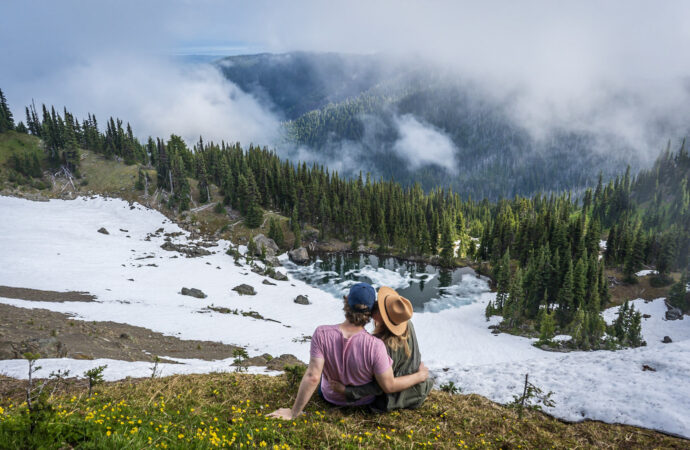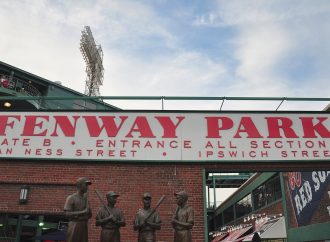The majestic peaks of the Olympic Range, lush rainforests, and coastal beaches are all packed into one incredible landscape. While most people plan their visits during the summer months, wintertime on the peninsula provides an entirely unique experience: one filled with wildlife sightings, hot spring soaks, and all the best explorations of the park, minus the crowds.
Olympic National Park is the fifth most visited National Park in America, but for eight months out of the year, the park is virtually empty. Once summer ends and the rain returns to the region, the parking lots, visitor centers, and trails that were packed to the gills with tourists in the summer are only seen by the hearty souls who brave the weather. The rainy season in Olympic National Park runs from October to June, and while the majority of visitors avoid the rainforest, mountains, and coastal regions of the park during these months, this is actually the best time to explore the beauty of the Pacific Northwest. Once the rain starts to fall, the park goes through changes that need to be seen and experienced by all.
November will undoubtedly be rainy, as well as noticeably dark because of the early hour of nightfall at that time of year. However, it can still be a wonderful time to visit. As the days grow shorter, people come together around the warmth of indoor fires, using cozy flannel blankets, and enjoying seasonal food. With the first snows come beautiful winter holiday lights.
“Yes, it will almost certainly be rainy. As night falls early, they come out and roam the Hoh Rain Forest. Although they’re only seen at night, their roars can be heard as early as November. This time of year is near human contact, and deer can be seen this close. For most people, the Mount Olympus Trail is better for hiking, though not many are willing to make the journey. Personally, I find the Hoh River Trail to be much more beautiful and enjoyable, but it may be difficult for some. Just make sure to bring a raincoat.
The beauty of the beaches is still evident in November, and the bald eagles and beauty of the tides is unsurpassed. I am a klutz and I always seem to fall but it is usually quite amusing. Be careful of the boardwalks as they can be very slippery when wet.
Some things to know:
- Beaches and other landmarks close after November and many reopen in May.
- With the exception of Barrow and Nome, all. The day had become decidedly autumnal by the time we finally arrived at the famous Spit. Despite the golden sunlight of the day and the curious and amiable pod of seals at the Lighthouse, our dejected mood persisted.
Olympic National Park in November
To be fair, the west side of the lake has more rainfall in November, but I don’t think you’re going to find a more beautiful place to spend your holiday. And deer love to hang out near the cottage! The west side of the lake has more rainfall in November, but it’s not enough to stop you from experiencing this breathtaking location. Deer love to hang out around the cottage!
November is the time of year when much of the high country is usually still open, and Hurricane Ridge is often sunny when it’s cloudy or rainy at sea level. If you’re in search of outdoor adventures, Obstruction Point Rd. is a perfect place to begin. I am more than confident that by the first week of November, both Hurricane Hill and the Switchback trails will be closed for the season.
Deer Lake in Olympic National Park
Dear readers, the beautiful trail to Deer Lake in Olympic National Park may be open for the first two weeks of November. This trail also takes you to Sol Duc Falls, which may also be open during the same time. Lake Angeles is only accessible by this trail, so climbing to Lake Angeles would be an excellent choice during this time. The Lake Angeles trail is 2400 feet high, so be prepared for a bit of an uphill climb. The view of Lake Angeles is incredibly scenic, with towering grey. You could hike up to Olympic Hot Springs for a wild setting. It is much less crowded and far cleaner in November than during the summer.
Harvest season
The long-awaited season of fresh food has arrived! Harvest season is the time of year when you can find the freshest fruit and vegetables of the season, as well as fresh dairy products. We all know it’s important to take advantage of this delicious harvest of foods! So, do yourself a favor and head on over to the nearest farm or vineyard to do some grocery shopping. We all know, you deserve it!
If you have children, you should visit Dungeness Valley Creamery, Christy Johnston’s Family Farm (lovely woman, lovely farm), and Nash Huber’s Farm Stand in the Dungeness Valley.
It’s no secret that November is a barren and dismal time. Yet there are a few things that can still make it worth visiting. The very early mornings are just as cold as the late evenings. But the weather is infinitely better than during the day. And if you’re visiting with friends. There’s no need to force yourself to do something as asinine as the oyster-eating competition.If you can’t handle the rain, don’t stop and wait, try again tomorrow. Here is a tip: for sunny, glorious weather and wildlife spotting, the best month is not August; it is September and the first week of October.
The amount of diversity in Olympic National Park’s landscape makes it so unique. The park hosts the longest stretch of wilderness coastline in the contiguous United States—73 miles of rugged and pristine coast. It’s coast is noted for towering sea stacks, old-growth forests and the wisdom that seems to flow from it’s ancient rocks. 95% of the National Park is congressionally-designated wilderness, meaning that it will remain untrammeled by man. The park is amazing with over 3,500 miles of rivers and streams, and 60 named glaciers. Mount Olympus rises high in the Olympic Mountain range, standing tall and proud at 7,980 feet. Because of the drastic differences in each environment, Olympic National Park is home to a wide array of wildlife—including 300 species of birds, 56 species of mammals (this includes marine and terrestrial mammals), 37 types of fish, and over 1,200 species of native plants.
Olympic National Park has something for everyone—whether you want to see the sights from your car and drive from area to area, embark on a five day backpacking trip retracing the footsteps of the historic Press Expedition, or something in-between, you are bound to find something that sparks your interest!
















Leave a Comment
Your email address will not be published. Required fields are marked with *